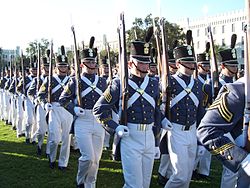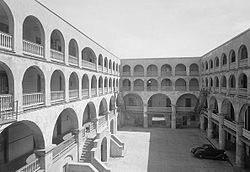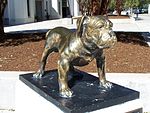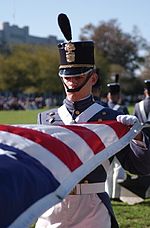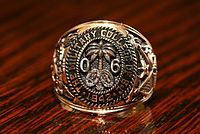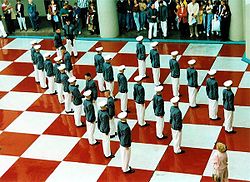- The Citadel, The Military College of South Carolina
-
The Citadel, The Military College of South Carolina 
Established 1842 Type Public university Endowment $166.8 million[1] President Lt Gen. John W. Rosa, Jr., USAF Students 3,300 Undergraduates 2,100 cadets, 100 non-cadets (active duty, veteran and evening students) Postgraduates 1,120 civilians Location Charleston, SC, USA
32°47′50″N 79°57′40″W / 32.79722°N 79.96111°WCoordinates: 32°47′50″N 79°57′40″W / 32.79722°N 79.96111°WCampus Urban, 300 acres (121 ha) Colors Blue and White Nickname Bulldogs Mascot Spike and live mascots General and Boo V, Website www.citadel.edu The Citadel, The Military College of South Carolina, also known simply as The Citadel, is a state-supported, comprehensive college located in Charleston, South Carolina, USA. It is one of the six senior military colleges in the United States. It has 14 academic departments divided into five schools offering 20 majors and 25 minors.
College overview
The Citadel is best known for its undergraduate Corps of Cadets military program which combines academics, physical challenges and military discipline.[2] In addition to the cadet program, civilian programs are offered through the Citadel Graduate College with its evening undergraduate and graduate programs. In a partnership with the local community college, Trident Technical College, Citadel bachelor's degrees are offered to evening civilian students in Business, Civil Engineering, and Electrical Engineering. Students must complete two years at the community college level and two years at the Citadel. This program is known as the 2 + 2 program.[3]
The Citadel enrolls over 2,100 undergraduate cadets in its residential military program and 1,200 civilian students in the evening programs. All students, both cadets and civilian students, are eligible to compete on the Citadel's athletic teams. While all programs make use of the Citadel campus and professors, cadets and civilian students do not share classes and only cadets live on campus.[2][3][4] The exception to this is the veterans program, reinstated in the fall of 2007, which allows cadets who left The Citadel for active military duty to return as civilians, attend classes with cadets, and complete their degrees if certain criteria are met.[5]
Cadets also share classes with active-duty enlisted Marine Corps and Navy personnel, who are not required to live on campus, and wear uniforms appropriate for their service area.
History
The Citadel presidents Capt William F. Graham, USA 1843–1844 Maj Richard W. Colcock, USA 1844–1852 Maj Francis W. Capers, CSA 1852–1859 Major Peters F. Stevens, SCM 1859–1861 Maj James B. White, SCM 1861–1865 Col John P. Thomas, CSA 1882–1885 BG George D. Johnston, CSA 1885–1890 Col Asbury Coward, CSA 1890–1908 Col Oliver J. Bond, SCM 1908–1931 Gen Charles P. Summerall, USA 1931–1953 Colonel Louis S. LeTellier, SCM 1953-1954, Acting Gen Mark W. Clark, USA 1954–1965 Gen Hugh P. Harris, USA 1965–1970 MG James A. Duckett, SCM 1970–1974 LTG George M. Siegnious, USA 1974–1979 VADM James A. Stockdale, USN 1979–1980 MG James Grimsley, Jr., USA 1980–1989 Lt Gen Cladius E. Watts, USAF 1989–1996 MG Roger C. Poole, SCM 1996–1997 MajGen John S. Grinalds, USMC 1997–2005 Lt Gen John W. Rosa, Jr., USAF 2006–present In response to a slave rebellion plot a municipal guard of 150 men was established in Charleston in 1822. Half the men were stationed in an arsenal called the citadel. Later, the South Carolina legislature replaced the expensive guardsmen with less expensive cadets and the arsenal was turned over to the newly established South Carolina Military Academy.[6][7] On December 20, 1842, the South Carolina Legislature passed an Act "to convert the Arsenal at Columbia, and the citadel and magazine in and near Charleston, into Military Schools" thereby transforming the two State Arsenals into the South Carolina Military Academy. The act specified:
That the students when admitted, shall be formed into a military corps, and shall constitute the public guard of the Arsenal at Columbia, and of the Citadel and Magazine in and near Charleston...to guard effectually, the public arms and other property at the places aforsaid...[8]
The first 20 cadets reported to The Academy, then located at Marion Square in downtown Charleston, on March 20, 1843. The name of the college was officially changed in 1910 to "The Citadel, The Military College of South Carolina". The word "Academy" had become synonymous with secondary schools, and the public had the misconception that the South Carolina Military Academy was a preparatory school.[9] When South Carolina seceded from the Union in December 1860, Major Robert Anderson moved his garrison of U.S. troops to Fort Sumter and requested reinforcements from the federal government. On January 9, 1861, SC Academy cadets George Edward Haynsworth and Samuel Bonneau Pickens were present when their unit fired two large cannon from their Morris Island station at the U.S. steamer, the Star of the West, preventing it from reaching Fort Sumter with troops and supplies and thus firing what are considered the first shots of the Civil War.
On January 28, 1861, the Corps of Cadets of The SC Academy was made part of the military organization of the state and named the Battalion of State Cadets. The Academy continued to operate as a military academy, but classes were often disrupted when the governor called the cadets into military service. Mounting and manning heavy guns, performing guard duty, providing security and escorting prisoners were among the services performed by the cadets. They were known as the Battalion of State Cadets and participated in the following engagements from 1861 to 1865. As a result of these services, The Citadel is authorized to carry nine Confederate battle streamers:
- Confederate States Army (larger gray)
- Star of the West, January 9, 1861
- Wappoo Cut, November 1861
- James Island, June 1862
- Charleston and Vicinity, July–October 1863
- James Island, June 1864
- Tulifinny, December 1864
- James Island, December 1864-February 1865
- Williamston, May 1865
In early December 1864, Governor Bonham ordered the Battalion of State Cadets to Tulifinny Creek to join a small Confederate force defending the Charleston and Savannah Railroad. On December 7 and December 9, the cadets fought Union forces, successfully defending the rail line and forcing Union forces to withdraw. The cadets suffered eight casualties at Tulifinny Creek. The battalion was commended for its display of discipline and gallantry under fire and won the admiration of the troops who fought with them. The flag of the Corps of Cadets includes eight battle streamers, representing these engagements, and one streamer representing the Confederate States Army.
On February 18, 1865, the school ceased operation as a college when Union troops entered Charleston and occupied the site.
Following the war, the Board of Visitors eventually regained possession of The Citadel campus, and the South Carolina Legislature passed an act to reopen the college. The 1882 session began with an enrollment of 185 cadets.
In the war with Spain in 1898, more Citadel alumni volunteered for service than were needed. In World War I, Citadel graduates were among the first contingents of American troops to fight with the English and French divisions. By that time, The Citadel had outgrown its campus on Marion Square, despite numerous building additions. In 1918, the city of Charleston offered the state of South Carolina 176 acres (71 ha) on the banks of the Ashley River for a new campus on the condition that the state fund the construction of a new Citadel campus there.[10] The state accepted the offer on February 26, 1919, and alloted $300,000 towards the construction of a new campus.[11] The college moved to its current location in 1922.
The title of the head of The Citadel was changed from Superintendent to President in 1921, when The Citadel moved to its present location. Col Oliver J. Bond was the last Superintendent and the first President of The Citadel.
Citadel graduates have performed military service for their country in major conflicts. The entire class of 1944 was inducted into the U.S. armed forces during World War II, and only two members graduated.
Rankings
 Replica of the Citadel flag flown by Cadets between 1861 to 1865
Replica of the Citadel flag flown by Cadets between 1861 to 1865
In 2011, The Citadel was named by U.S. News & World Report as the Number 1 public college in the south and #5 among "All (public and private) master's degree granting colleges and universities in the South"; the school has also routinely been ranked as one of the best values among all institutions in the South".[12]
Engineering students are among the most highly-recruited students from The Citadel, and its School of Engineering is ranked 21st among all undergraduate engineering programs in the United States. The civil engineering program is ranked No. 8 in undergraduate engineering specialty programs.[13]
Kiplinger's magazine, in its ranking of the "Best Values in Public Colleges" for 2006, made mention of The Citadel as a "great value" although the military nature of its program excluded it from consideration as a "traditional" four-year college in its rankings.[14]
The Citadel ranks first nationally among its peers for the percentage of students who graduate on time, and Citadel cadets are twice as likely as their peers in other colleges to graduate in four years. The Citadel's top ranking comes from a comparison of all public colleges whose entering students have average SAT scores between 1000 and 1200. The Citadel's four-year graduation rate is 69%, and its six-year rate is 71.9%.[15]
Student life
Undergraduate cadets at The Citadel are members of the South Carolina Corps of Cadets. Cadets must meet physical fitness and SAT/ACT testing standards for acceptance into the Corps of Cadets.[16] On occasion, waivers to height/weight standards can be granted upon successful completion of the physical training test. On most days, cadets have both morning and afternoon physical (fitness) training, called "PT", military instruction on leadership, weapons, drill, and discipline, in addition to their regular college classes.
Most weekdays start with a formal muster and inspection of all personnel and their rooms. Cadets then march to structured military meals. After a day spent in classes, sports and other activities, the day usually ends with an evening muster formation and mandatory evening study period. Cadets are usually allowed to go out on weekends but must sleep overnight in the barracks unless they have a special pass.
Because The Citadel emphasizes corps unity and discipline, cadets may not be married and must live on campus in the barracks with their assigned company. The Citadel emphasizes an extremely strict disciplinary and physical fitness indoctrination for fourth-class cadets, who are called knobs because of the shaved heads they must maintain until the end of their first year when they are then recognized as upperclassmen.
Cadets who accumulate too many demerits or breach regulations can be punished by serving confinements or tours. A tour is one hour spent marching in the barracks with a rifle at shoulder arms and is normally performed when a cadet would otherwise be permitted to leave campus. A confinement is one hour spent in a cadet's room when they would normally be permitted to leave campus.
First class cadets, those in their senior year, receive their class rings at a special ring presentation ceremony, which was previously held in the college's chapel, but which now takes place in the school's field house. The Citadel ring is 10 karat gold with no gem stone and is one of the heaviest all-precious/semi-precious metal college rings in the United States. The design is common to all cadets and the design does not change with each class with the exception of the class year. Active-duty and evening undergraduate students receive a ring which is the same size, but with a different design.[17]
Included in The Citadel Graduate College student body are numerous active duty Marine and Navy enlisted personnel attending The Citadel under the Seaman To Admiral program (STA-21)[18] and the Marine Enlisted Commissioning Education Program (MECEP).[19]
The Citadel Regimental Pipe Band is one of the two all-student college pipe bands in the country, and it regularly performs at the weekly parade at The Citadel as well as at other events. The pipe band was started by General Mark Clark in 1955. The Regimental Band and Pipes were the only U.S. unit to perform at the 2010 Silver Jubilee of the Edinburgh Military Tattoo in Scotland and also performed there in 1991.
Athletics
Main article: The Citadel BulldogsThe Citadel is a NCAA Division I school and a member of the Southern Conference. The college's mascot is the Bulldog. Those cadets who participate in NCAA fall athletics (football, cross country, women's soccer and volleyball) are required to report a month earlier prior to their freshman year for "athletic cadre," so that they can participate in their sport practices when normal cadre starts. During the athletic cadre, the military athletes are initiated into the Corps while completing first-week experiences, such as "Hell Week".
The Citadel Bulldogs baseball team has won thirteen regular season Southern Conference championships, most recently in 2010. The 1990 Citadel baseball team won the Atlantic Regional, earning the school its first trip to the College World Series and finishing the season ranked sixth in the final Collegiate Baseball poll with a record of 46–14; they also became the first military school to play in the CWS. Numerous alumni have played in the major leagues in recent years.
Several alumni have played in the NFL including current WR/KR Andre Roberts of the Arizona Cardinals and CB Cortez Allen of the Pittsburgh Steelers. FB Nehemiah Broughton '05 also recently played with the Redskins, Cardinals and Giants; K Greg Davis '87played for several teams Including Arizona and Atlanta, ESPN color commentator Paul Maguire '60 played for the Buffalo Bills and former Cardinals running back Lyvonia "Stump" Mitchell '81 is the current head coach at Southern University and served as an assistant for the Seahawks and Redskins.
Minority and female students
Charles Foster became the first African-American cadet to graduate from the Citadel. He graduated in 1970 and he was well known for his success in ROTC.
Norman Seabrooks became the first African American cadet to captain a Football team.
Norman Doucet of the Class of 1994 was the first African American Cadet Regimental Commander of The Citadel.[20]
The Corps of Cadets at The Citadel was all-male until August 1996, although women had attended civilian graduate evening programs at the school for many years.
On January 20, 1994, Shannon Faulkner became the first female student to enroll in day classes at The Citadel. After additional legal battles, Faulkner won the right to enroll in the residential Corps of Cadets program. She joined an otherwise all-male class on August 15, 1995. However, after only four hours of military indoctrination training, she spent the majority of the first week in the medical infirmary and then voluntarily resigned citing emotional and psychological abuse and physical exhaustion. In the fall 1996, four more women enrolled at the Citadel (Nancy Mace, Petra Lovetinska, Kim Messer and Jeanie Mentavlos.) While two (Kim Messer and Jeanie Mentavlos) dropped out after four months citing harassment, Nancy Mace became the first female cadet to graduate from The Citadel on May 8, 1999. Using credits earned from a two-year community college, Mace graduated in three years. Mace's father, Brigadier General Emory Mace, became the Commandant of Cadets during her second semester at The Citadel.
The first international female cadet was Czech-born Petra Lovetinska-Seipel, who graduated May 2000. Lovetinska holds the rank of major in the U.S. Marine Corps and served in the Iraq War. She is married to a fellow Marine officer, Major Patrick Seipel.
In May 2002 the first African American women [[Toshika "Peaches" Hudson of Columbia, S.C; Renee Hypolite of Philadelphia, Pa.; Natosha Mitchell of Dyersburg, Tenn.; Geneive Hardney of Staten Island, N.Y.; Lesjanusar "Sha" Peterson of Chicago, Ill.; Adrienne Watson of Sanford, N.C.; and Jamey McCloud of Wadmalaw Island, S.C]] - seven cadets in all - graduated from the Citadel. [1]
The Citadel, like the United States military, has adopted gender norming for physical fitness tests.
Campus
 Checkerboard Quadrangle of Padgett Thomas Barracks
Checkerboard Quadrangle of Padgett Thomas Barracks
The Citadel sits on a 300-acre (120 ha) tract of land on the Ashley River. There are 27 buildings grouped around a 10-acre (4.0 ha) grass parade ground. The buildings around the parade ground include ten classroom buildings, an administrative building, five barracks, a student activities building, infirmary, chapel, stadium, a yacht club, a marksmanship center, a field house, and library. The campus is bounded on the west by the Ashley River, to the north by the Wagener Terrace neighborhood, and to the east by Hampton Park and the Hampton Park Terrace neighborhood. Just off the main campus are the football stadium, baseball stadium, and alumni center. Additionally, there is a large beach house facility located near the north end of the Isle of Palms.
The Citadel Graduate College
The Citadel’s evening graduate program serves the Lowcountry by offering regionally and professionally accredited bachelors, masters and specialist degrees scheduled around the student’s profession, family and lifestyle. CGC offers 19 graduate programs with concentrations in education, psychology, computer science and business.[21] The Masters of Business Administration program is the only nationally accredited MBA program in the Low Country region of South Carolina. CGC also offers undergraduate evening programs in business and engineering. The Citadel is also the only college in South Carolina that offers an undergraduate civil and electrical engineering degree in an evening program.
Core values
In its Vision Statement, the Citadel Board of Visitors identifies the following as the school's "core values:"
- Honor: First and foremost honor includes adherence to the Honor Code of The Citadel. A cadet “will not lie, cheat or steal, nor tolerate those who do”. The commitment to honor extends beyond the gates of The Citadel and is a life-long obligation to moral and ethical behavior. In addition, honor includes integrity; “doing the right thing when no one is watching”. Finally, honorable behavior includes exercising the moral courage to “do the right thing when everyone is watching”. The Honor Code is the foundation of our academic enterprise.
- Duty: First and foremost duty means to accept and accomplish the responsibilities assigned to me. At The Citadel, my primary duty is to perform academically and then to perform as a member of the Corps of Cadets and the campus community. I accept the consequences associated with my performance and actions. Once I have held myself accountable for my actions, then I will hold others accountable for their actions. Finally, duty means that others can depend on me to complete my assignments and to assist them with their assignments. Duty is also a call to serve others before self.
- Respect: First and foremost respect means to treat other people with dignity and worth – the way you want others to treat you. Respect for others eliminates any form of prejudice, discrimination, or harassment (including but not limited to rank, position, age, race, color, gender, sexual orientation, national origin, religion, physical attributes, etc.). In addition, respect for others means to respect the positions of those in authority which include faculty, staff, administrators, active duty personnel and the leadership of the Corps of Cadets. Finally, respect includes a healthy respect for one’s self.
No lock tradition
Since its founding, male cadets at the Citadel had not had locks on their barracks doors. Every cadet had a lockbox, however, that could be used to house valuables. The tradition evolved in keeping with the spareness of military life and with the school's honor code, which mandates that cadets do not steal. Since 1997, female cadets have been able to lock their doors from the inside. In 2007, all barracks doors were fitted with working locks.[22] As of 2009 all knobs are required to lock their rooms after Taps.
“ This decision in no way compromises the honor system. The personal standards that a cadet does not lie, cheat or steal, nor tolerate those who do, remains the centerpiece of The Citadel experience.
Lt. Gen. John W. Rosa, USAF (Ret)[22]” Enrollment and Tuition
Approximately half of Citadel's enrollment is from the state of South Carolina.[23] The Citadel has graduated students from across the U.S. and from many other countries. South Carolina residents receive a discount in tuition, as is common at state-sponsored schools, although The Citadel receives only about 10% of its budget from the state.[24] Total first year expenses (tuition, fees, uniforms, housing, meals, etc..) for the 2009-2010 academic year were $21,994 for South Carolina residents and $35,804 for all others.[25]
Military service
All cadets are required to undergo four years of ROTC training in one of the four branches of the armed services, but they are not required to enter military service after graduation. Civilian students may opt to attend. Currently, just over forty percent of graduates go into military service (including the US Coast Guard), and less than ten percent make the military a career. The others go on to graduate, law, or medical school programs or enter the civilian workforce. Over the years, 264 Citadel alumni have reached the top ranks in the military by becoming flag officers (generals, rear admirals or commodores).[26] Alumni of the Citadel have served their country in all wars involving the United States since the school's establishment. Citadel alumni have been killed in action during the Civil War (67), World War I (15), World War II (280), Korean War (32), Vietnam War (68), Lebanon (1), Grenada (1), the Gulf War (1), and the current conflicts in Iraq and Afghanistan (12).[26] Alumni also serve in other countries, including five four-star generals in the Royal Thai Army.[26]
Summer camp
"The Citadel Summer Camp", a summer camp for boys and girls ages 10 to 15, was held at The Citadel every summer from 1957 until 2006. Founded by General Mark Wayne Clark, its purpose was to develop and strengthen the physical, mental, ethical, spiritual, patriotic and social characteristics of campers.[27] The Citadel Summer Camp ceased operation in 2006 because of financial issues, space limitations and pressure from several pending lawsuits.[28]
Cadet Officer Leadership School
Selected members of Air Force JROTC units from the Southeastern United States cadets are eligible to spend a week at the Citadel for officer training for their home JROTC units. A routine day attending Cadet Officer Leadership School (COLS) begins with waking up to Reveille for morning PT. This includes aerobic stretches, push ups, sit ups, and then a mile run. The remainder of the day is uniform wear and inspection, two classes and constant regulation drill. On the day of graduation from the school, cadets participate in a "pass in review" ceremony where awards and decorations are given to certain cadets who have gone above the normal standards. A PT ribbon and a Leadership School ribbon are given to all cadets who graduate from COLS back at their home unit. A Leadership ribbon is given to all Cadre, or cadet leaders, who graduate from the program, also back at their home unit at the beginning of the school year. Units that have a 100% PT(physical training) pass rate also receive a Colonel Sercer award, which includes a plaque and a certificate for the unit to display wherever they see fit.
Notable graduates
Main article: Notable alumni of The Citadel, The Military College of South CarolinaFictional depictions
- Pat Conroy's 1980 novel The Lords of Discipline was based in part on Conroy's experience as a cadet at The Citadel during the 1960s and on his research of other military schools. This book is a fictitious account of the first African American cadet at The Citadel and the class struggle that ensued to both keep and reject the cadet. The novel outraged many of his fellow graduates of The Citadel, who felt that the book was a thinly veiled portrayal of campus life that was highly unflattering. The rift was not healed until 2000, when Conroy was awarded an honorary degree and asked to deliver the commencement address the following year. That year Conroy spearheaded fundraising to renovate the banquet hall in The Citadel Alumni Association building The Lords of Discipline was made into a movie of the same name starring David Keith and Robert Prosky in 1983.
- Sword Drill, a novel by David Epps (Citadel Class of 1980), presents a fictional version of the Citadel’s now disbanded Junior Sword Drill program.[2]
- A thinly veiled depiction of the Citadel provides the background for Calder Willingham's novel End as a Man and the film adaptation, The Strange One.
- The Citadel was used as the location for shooting the 1974 episode Columbo "By Dawn's Early Light," guest starring Patrick McGoohan.
- Major Ben Marco, Denzel Washington's character in the movie The Manchurian Candidate, was a graduate of The Citadel.
- In the film For the Boys, Bette Midler's son graduates as Regimental Commander of the Corps of Cadets. His commencement speech is filmed in front of 2nd Battalion Barracks.
- Several scenes of the movie Dear John were filmed at The Citadel.
- Portions of the music video for Dave Matthews Band, "American Baby" were filmed at The Citadel.
- The Citadel, a novel written by Tom Schroder in 2000.
References
- ^ As of June 30, 2009. "U.S. and Canadian Institutions Listed by Fiscal Year 2009 Endowment Market Value and Percentage Change in Endowment Market Value from FY 2008 to FY 2009" (PDF). 2009 NACUBO-Commonfund Study of Endowments. National Association of College and University Business Officers. http://www.nacubo.org/Documents/research/2009_NCSE_Public_Tables_Endowment_Market_Values.pdf. Retrieved March 9, 2010.
- ^ a b Quick Facts from the Citadel web site.
- ^ a b CPGS Overview from the Citadel web site.
- ^ America's Best Colleges 2008: The Citadel USNews.com
- ^ Citadel reinstates veterans program The Citadel Public Affairs Office
- ^ "Denmark Vesey", Knob Knowledge, Daniel Library, The Citadel, The Military College of South Carolina.
- ^ "About The Citadel", Office of Public Affairs, The Citadel, The Military College of South Carolina, May 2001.
- ^ John P. Thomas, History of the South Carolina Military Academy 1783-1892(Charleston, SC, Walker, Evans & Cogswell Co., 1893)p.5-6
- ^ Oliver J. Bond, The Story of The Citadel (Richmond, VA, Garrett and Massie) pp 168-170
- ^ "195 acres (79 ha) land Donated by City", The Charleston (S.C.) Evening Post: 10, December 11, 1918
- ^ "Citadel Bill Is Safely Passed", The Charleston (S.C.) Evening Post: 6, February 27, 1919
- ^ America's Best Colleges 2009, U.S. News & World Report web site.
- ^ The Citadel remains top ranked by U.S.News for both quality, value The Citadel website.
- ^ Lankford, Kimberly (2006). Best Values in Public Colleges. Kiplinger's.
- ^ Graduation rates Citadel Press Release.
- ^ Admissions policy The Citadel website.
- ^ The Ring The Buoniconti Fund website.
- ^ STA-21
- ^ The Citadel MECEP Platoon | Turning Flat Black to Gold Since 1973
- ^ Citadel names 1st Black student as commander findarticles.com
- ^ In 2007 The Citadel changed its graduate program's name from the College of Graduate and Professional Studies (CGPS) to The Citadel Graduate College (CGC).
- ^ a b Citadel News Service (2007-04-21). "Board Approves Plan to Put Locks in Barracks" (Press release). The Citadel. http://externalaffairs.citadel.edu/locks_in_barracks.
- ^ "The Citadel, The Military College of South Carolina". The Princeton Review. 2010. http://www.princetonreview.com/schools/college/CollegeBasics.aspx?iid=1022887.
- ^ As of 2010, Knich, Diane (2010-04-17). "Citadel Tuition May Rise". Charleston Post and Courier. http://www.postandcourier.com/news/2010/apr/17/citadel-tuition-may-rise/. Retrieved 2010-05-19.
- ^ "Tuition and Fees". The Citadel. http://www.citadel.edu/treasurer/tuition.html. Retrieved 2010-05-19.
- ^ a b c "Alumni Achievement". Citadel Alumni Association. 2010-05-12. http://www.citadelalumni.org/dcal/statistics.php.
- ^ The Citadel Summer Camp
- ^ Citadel named in lawsuit
External links
The Citadel, The Military College of South Carolina Athletics Teams: Baseball • Basketball • Football • Wrestling
Facilities: Joseph P. Riley, Jr. Park • McAlister Field House • Johnson Hagood StadiumStudent life The Summerall Guards • Regimental Band
People Presidents William F. Graham • Richard W. Colcock • Francis W. Capers • Peter F. Stevens • James B. White • John P. Thomas • George D. Johnston • Asbury Coward • Oliver J. Bond • Charles P. Summerall • Mark W. Clark • Hugh P. Harris • James W. Duckett • George M. Seignious • James B. Stockdale • James A. Grimsley • Claudius E. Watts III • John Grinalds • John Rosa
Southern Conference Current members Appalachian State Mountaineers • Chattanooga Mocs • The Citadel Bulldogs • College of Charleston Cougars • Davidson Wildcats • Elon Phoenix • Furman Paladins • Georgia Southern Eagles • Samford Bulldogs • UNC Greensboro Spartans • Western Carolina Catamounts • Wofford Terriers
Former members List of former Southern Conference members
Championships & awards Southern Conference Hall of Fame
Federal service academies UndergraduatePost-graduateSenior military colleges PublicPrivateJunior military colleges PublicPrivateUnited States staff colleges National Defense University · Joint Forces Staff College · Defense Language Institute · U.S. Army War College · Command and General Staff College · School of Advanced Military Studies · Marine Corps University · Marine Corps War College · Naval War College · Naval Postgraduate School · Air University · Air Command and Staff College · Air War College · Air Force Institute of Technology · Community College of the Air Force · U.S. Army Warrant Officer Career CollegePublic institutions The Citadel · Clemson · Coastal Carolina · College of Charleston · Francis Marion · Lander · South Carolina State · USC Aiken · USC Beaufort · USC Columbia · USC Lancaster · USC Salkehatchie · USC Sumter · USC Union · USC Upstate · Winthrop
Private institutions Allen · Anderson · Benedict · Bob Jones · Charleston Southern · Claflin · Columbia · Columbia International · Coker · Converse · Erskine · Furman · Limestone · Morris · Newberry · North Greenville · Presbyterian · Sherman · Southern Wesleyan · Spartanburg Methodist · Voorhees · Wofford
Community Colleges Aiken TC · Central Carolina TC · Denmark TC · Florence-Darlington TC · Greenville TC · Horry-Georgetown TC · Midlands TC · Northeastern TC · Orangeburg-Calhoun TC · Piedmont TC · Spartanburg CC · Technical College of the Lowcountry · Tri-County TC · Trident TC · Williamsburg TC · York TC
Seminaries, graduate, and
professional institutionsCategories:- The Citadel, The Military College of South Carolina
- Educational institutions established in 1842
- Military education and training in the United States
- Education in Charleston, South Carolina
- Universities and colleges accredited by the Southern Association of Colleges and Schools
- American Association of State Colleges and Universities
- Universities and colleges in South Carolina
- United States senior military colleges
Wikimedia Foundation. 2010.

